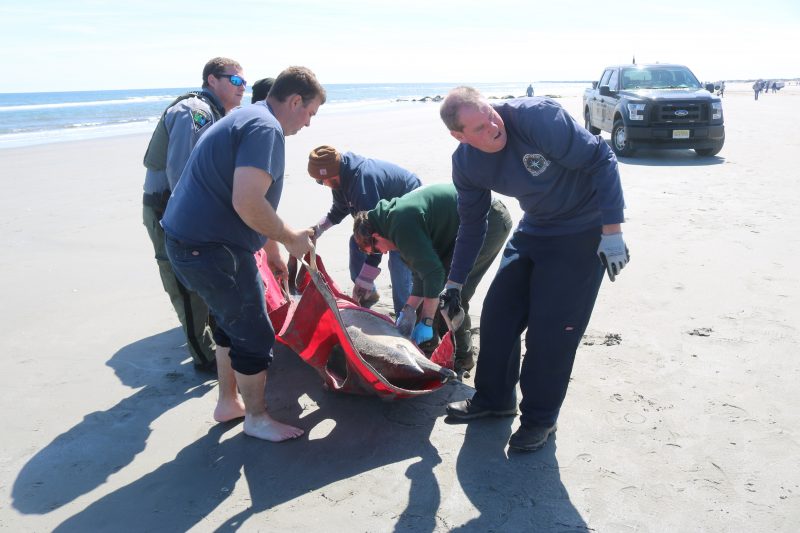
By DONALD WITTKOWSKI
Beachgoers may have felt relieved when they were able to push a stranded dolphin back into the ocean Monday in Sea Isle City.
The male common dolphin, though, proved too weak to survive on its own and ended up back on the beach a few hours later. Ultimately, it was euthanized, authorities say.
The sad scene played out on Sea Isle’s 29th Street beach around 7 a.m. Monday, when beachgoers found the young dolphin in poor condition and tried to save it, according to the Marine Mammal Stranding Center.
“Beachgoers tried to push it back in the ocean and it beached itself again to become re-stranded. It’s a sad thing, of course,” Sea Isle spokeswoman Katherine Custer said in an interview Wednesday.
NJ.com was the first to report on the stranded dolphin. A report on the Marine Mammal Stranding Center’s website characterized the dolphin as underweight, lethargic and in “poor body condition” overall.
The dolphin’s remains were sent to the New Jersey Animal Health Diagnostic Laboratory for a necropsy. The results are pending.
Custer said Sea Isle police officers were initially called to the scene after a member of the public discovered the dolphin at 29th Street. Police then alerted the Marine Mammal Stranding Center in Brigantine.

In March, eight other common dolphins became stranded on the beach in Sea Isle. Police officers and other first responders used buckets and fire hoses to pour seawater on the dolphins in a frantic effort to save the creatures after they washed ashore near 51st Street and 52nd Street.
Two of the dolphins died shortly after they became beached. Ultimately, the rescue attempt for the six other dolphins proved futile. A veterinarian from the Marine Mammal Stranding Center decided to euthanize the dolphins after their condition deteriorated.
Another common dolphin was found dead in Sea Isle in May.
Other dolphins have washed up along the Jersey Shore this year, but the mass stranding of eight in Sea Isle last March was the largest single group to die so far.
Figures on the Marine Mammal Stranding Center’s website Cetaceans 2002-2023 (mmsc.org) covering the years 2002 to 2023 show that a total of 48 dolphins and porpoises have washed up in New Jersey in 2023, far fewer than the high of 186 in 2013.
In addition, 13 dead whales, including nine humpbacks, have washed up in New Jersey so far in 2023, according to the standing center’s data.
The 13 dead whales this year is the highest annual number for the period covering 2002 to 2023. Twelve dead whales washed ashore in New Jersey in both 2019 and 2020, the stranding center’s figures show.

More dead whales and dolphins have washed up along other East Coast states in 2023. There are suspicions that sonar mapping of the seabed for a series of proposed offshore wind energy farms along the East Coast may be contributing to the mammals’ deaths. One of the wind farms is proposed 15 miles off the New Jersey coast from Atlantic City to Stone Harbor.
The National Oceanic and Atmospheric Administration, the New Jersey Department of Environmental Protection and the Marine Mammal Stranding Center are among the government agencies or organizations that dispute any connection between the wind farms and the dead whales and dolphins.
NOAA and the Marine Mammal Stranding Center have concluded that most of the whale deaths were caused by vessel strikes after examining the carcasses and finding the types of injuries consistent with collisions with ships.
Wind farm opponents, though, strongly suspect that at least some of the whale deaths may have been caused by preliminary surveying work of the seabed for the offshore wind projects.







